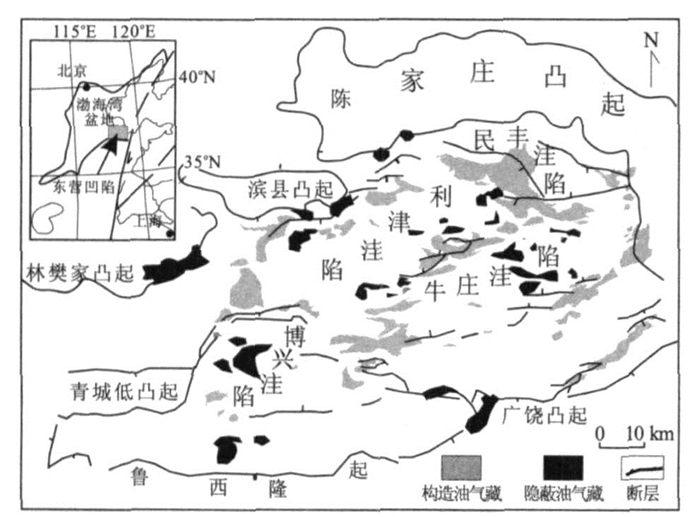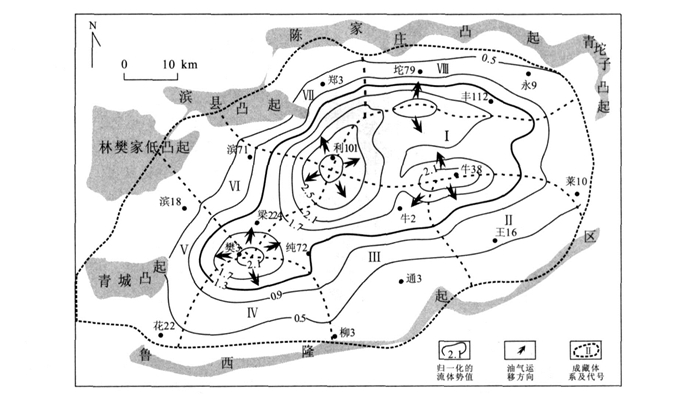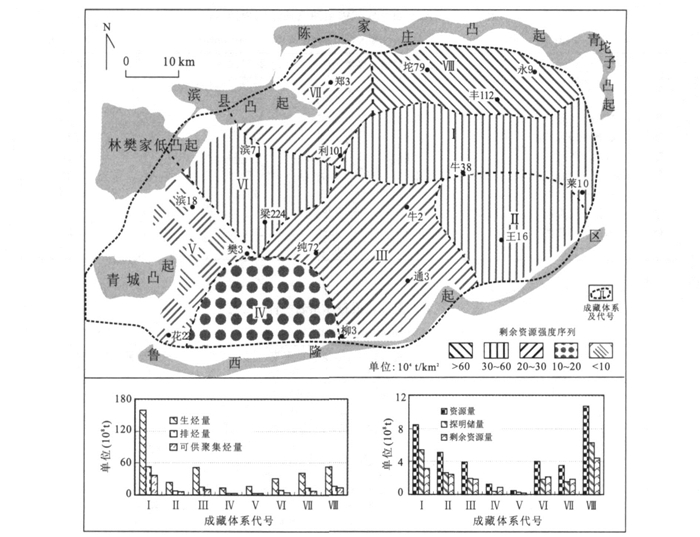Division and Quantitative Evaluation of Petroleum Accumulation System in Dongying Sag
-
摘要: 油气成藏体系作为油气评价单元的一种全新的研究思路, 与勘探目标结合更加紧密, 油气成藏门限从定量的角度阐述油气藏的形成及分布规律, 尤其对于高勘探程度的地区而言, 剩余资源的预测更为准确.在对东营凹陷油气成藏体系划分的基础上, 利用油气成藏门限理论对各成藏体系进行了定量评价.结果表明: 东营凹陷所划分的8个成藏体系都进入了成藏门限和资源门限, 凹陷总剩余资源量为17.03×108 t; 其中, 成藏体系Ⅷ、Ⅰ的剩余资源最大, 分别为4.41×108 t、3.10×108 t; 而成藏体系Ⅵ、Ⅴ最小, 分别为0.90×108 t、0.22×108 t; 其余成藏体系介于其间.可知, 成藏体系Ⅷ、Ⅰ为最有利勘探潜力区.Abstract: The theory of oil accumulation threshold describes the formation and distribution of reservoirs quantitatively, which is better than other theories in predicting undiscovered resources in mature exploration area. In this article, Dongying sag was divided into eight petroleum accumulation system, and they were quantitatively estimated by the the theory of oil accumulation threshold. The results shows that all of them have entered their thresholds of oil accumulation and resources. The total resources undiscovered is 17.03×108 t in Dongying sag. Ⅷ and Ⅰ petroleum accumulation systems have 4.41×108 t and 3.10×108 t undiscovered resources, respectively, which are much more than rest petroleum accumulation systems. Ⅵ and Ⅴ petroleum accumulation systems have the least undiscovered resources 0.90×108 t and 0.22×108 t, respectively. So Ⅷ and Ⅰ petroleum accumulation systems are the potential areas to explore.
-
图 2 含油气系统与油气成藏体系概念的区别和联系(庞雄奇等, 2003a)
Fig. 2. Diagrams showing differences and relations between petroleum system and petroleum accumulation system
表 1 东营凹陷沙河街组油气成藏体系主要特征
Table 1. The main characters of petroleum accumulation system of Shahejie Formation, Dongying sag

表 2 东营凹陷油气成藏体系油气成藏门限数据
Table 2. Data of petroleum accumulation threshold of all petroleum accumulation systems in Dongying sag

表 3 东营凹陷油气成藏体系油气资源数据
Table 3. Data of petroleum resources of all petroleum accumulation systems in Dongying sag

-
Fu, X. T., Lu, S. F., 1997. Dissolving character for the components of natural gas and its significance. Geochimica, 26 (3): 60-66 (in Chinese with English abstract). Hao, S. S., Zhang, Z. Y., 1993. The chavtacteristic of the solubility of natural gas in formation waters and its geological significance. Acta Petrolei Sinica, 14 (2): 12-22 (in Chinese with English abstract). Hao, X. F., Chen, H. H., Gao, Q. L., et al., 2006. Micro-charging processes of hydrocarbon in the Niuzhuang lentoid sandy reservoirs, Dongying depression. Earth Science—Journal of China University of Geosciences, 31 (2): 182-190 (in Chinese with English abstract). Hu, C. Y., 1982. Source bed controls hydrocarbon habitat in continental basins, East China. Acta Petrolei Sinica, 3 (2): 9-13 (in Chinese with English abstract). Hu, J. Y., Tong, X. G., Xu, S. B., 1986. Formation and distribution of complex petroleum accumulation zones in Bohaiwan basin. Petroleum Expoloration and Development, (1): 1-8 (in Chinese with English abstract). Jiang, Z. X., Fu, G., 1994. Oil-gas migration type and supplying unit characteristics of Fuyu oil layer in Sanzhao area. Natural Gas Industry, 14 (6): 24-27 (in Chinese with English abstract). Jiang, Z. X., Pang, X. Q., Jin, Z. J., et al., 2002. Threshold control over hydrocarbons and its application in distinguishing valid source rock. Earth Science—Journal of China University of Geosciences, 27 (6): 689-695 (in Chinese with English abstract). Jiang, Z. X., Zhao, W. Z., Li, W., 1997. New method of petroleum system division and its application. Explorationist, 2 (1): 38-41 (in Chinese with English abstract). Li, M. C., 1994a. Migration of oil and gas (2nd edition). Petroleum Industry Press, Beijing (in Chinese). Li, M. C., 1994b. Present status of hydrocarbons migration research and its development. Petroleum Exploration and Development, 21 (2): 1-6 (in Chinese with English abstract). Li, S. M., Qiu, G. Q., Jiang, Z. X., et al., 2007. Origin of the subtle oils in the Niuzhuang sag. Earth Science—Journal of China University of Geosciences, 32 (2): 213-218 (in Chinese with English abstract). Lin, C. S., Pan, Y. L., Xiao, J. X., et al., 2000. Structural slope-break zone: Key concept for stratigraphic sequence analysis and petroleum forecasting in fault subsidence subsidence basins. Earth Science—Journal of China University of Geosciences, 25 (3): 260-266 (in Chinese with English abstract). Liu, X. C., Qian, K., Wu, S. X., 1996. Theory of corresponding distribution of fields and oil-gas girdles in Dongying depression. Oil & Gas Geology, 17 (3): 185-189 (in Chinese with English abstract). Magoon, L. B., Dow, W. G., 1994. The petroleum system: From source to trap. AAPG Memoir, 60: 3-24. Pang, X. Q., Jiang, Z. X., Li, J. Q., et al., 2000. Geologic thresholds in the process of forming old and gas reservoir and their functions of controlling petroleum. Journal of China University of Petroleum, 24 (4): 53-57 (in Chinese with English abstract). Pang, X. Q., Jin, Z. J., Jiang, Z. X., 2003a. Quantitative models of hydrocarbon accumulation (Volume 8). Petroleum Industry Press, Beijing (in Chinese). Pang, X. Q., Li, P. L., Jin, Z. J., et al., 2003b. Hydrocarbon accumulation threshold and its application in Jiyang depression. Oil & Gas Geology, 24 (3): 204-209 (in Chinese with English abstract). Shi, J. A., Deng, J. H., Zeng, F. G., et al., 2002. An experiment on physically simulating secondary oil migration and analysis of dissipating features. Acta Sedimentologica Sinica, 20 (2): 333-338 (in Chinese with English abstract). Song, Z. X., 1987. The selection of evaluation modes of oil and gas resources. Acta Sedimentologica Sinica, 5 (1): 104-113 (in Chinese with English abstract). Wu, S. C., 1994. Introduction of geological evaluation on petroleum resource. Petroleum Industry Press, Beijing, 1-125 (in Chinese). Xie, G. J., Jin, Z. J., Xiao, H. Q., et al., 2003. Undiscovered pool sizes prediction of higher exploration degree area. Petroleum Exploration and Development, 30 (3): 16-18 (in Chinese with English abstract). Zhao, X. D., 1986. China mathematical geology (Serial 1). Geology Press, Beijing, 1-172 (in Chinese). Zhou, H. Y., Pang, X. Q., Jiang, Z. X., 2002. Key factors controlling migration and accumulation efficiency of oil and gas and their quantitative evaluation. Petroleum Exploration and Development, 29 (1): 14-18 (in Chinese with English abstract). Zhou, H. Y., Pang, X. Q., Jiang, Z. X., et al., 2003. Hydrocarbon accumulation threshold and its study methods. Acta Petrolei Sinica, 24 (6): 40-44 (in Chinese with English abstract). Zhu, G. Y., Jin, Q., Zhang, S. C., et al., 2003. Forming mechanisms and heterogeneity of source rock: A case study in Dongying depression. Journal of Mineralogy and Petrology, 23 (4): 95-100 (in Chinese with English abstract). 付晓泰, 卢双舫, 1997. 天然气组分的溶解特征及其意义. 地球化学, 26 (3): 60-66. doi: 10.3321/j.issn:0379-1726.1997.03.008 郝石生, 张振英, 1993. 天然气在地层水中的溶解度变化特征及地质意义. 石油学报, 14 (2): 12-22. doi: 10.3321/j.issn:0253-2697.1993.02.004 郝雪峰, 陈红汉, 高秋丽, 等, 2006. 东营凹陷牛庄砂岩透镜体油气藏微观充注机理. 地球科学——中国地质大学学报, 31 (2): 182-190. https://www.cnki.com.cn/Article/CJFDTOTAL-DQKX200602006.htm 胡朝元, 1982. 生油区控制油气田分布——中国东部陆相盆地进行区域勘探的有效理论. 石油学报, 3 (2): 9-13. https://www.cnki.com.cn/Article/CJFDTOTAL-SYXB198202001.htm 胡见义, 童晓光, 徐树宝, 1986. 渤海湾盆地复式油气聚集区(带) 的形成和分布. 石油勘探与开发, (1): 1-8. https://www.cnki.com.cn/Article/CJFDTOTAL-SKYK198601000.htm 姜振学, 付广, 1994. 三肇地区扶余油层油气运移形式及供油单元特征. 天然气工业, 14 (6): 24-27. https://www.cnki.com.cn/Article/CJFDTOTAL-TRQG406.005.htm 姜振学, 庞雄奇, 金之钧, 等, 2002. 门限控烃作用及其在有效烃源岩判别研究中的应用. 地球科学——中国地质大学学报, 27 (6): 689-695. https://www.cnki.com.cn/Article/CJFDTOTAL-DQKX200206006.htm 姜振学, 赵文智, 李伟, 1997. 应用高势面划分含油气系统及其应用. 中国石油勘探, 2 (1): 38-41. 解国军, 金之钧, 肖焕钦, 等, 2003. 成熟探区未发现油藏规模预测. 石油勘探与开发, 30 (3): 16-18. doi: 10.3321/j.issn:1000-0747.2003.03.005 李明诚, 1994a. 石油与天然气运移(第二版). 北京: 石油工业出版社. 李明诚, 1994b. 油气运移研究的现状与发展. 石油勘探与开发, 21 (2): 1-6. https://www.cnki.com.cn/Article/CJFDTOTAL-SKYK402.000.htm 李素梅, 邱桂强, 姜振学, 等, 2007. 牛庄洼陷"岩性油气藏"油气成因. 地球科学——中国地质大学学报, 32 (2): 213-218. https://www.cnki.com.cn/Article/CJFDTOTAL-DQKX200702008.htm 林畅松, 潘元林, 肖建新, 等, 2000. "构造坡折带"——断陷盆地层序分析和油气预测的重要概念. 地球科学——中国地质大学学报, 25 (3): 260-264. https://www.cnki.com.cn/Article/CJFDTOTAL-DQKX200003008.htm 刘兴材, 钱凯, 吴世祥, 1996. 东营凹陷油气场环对应分布论. 石油与天然气地质, 17 (3): 185-190. doi: 10.3321/j.issn:0253-9985.1996.03.003 庞雄奇, 姜振学, 李建青, 等, 2000. 油气成藏过程中的地质门限及其控制油气作用. 石油大学学报(自然科学版), 24 (4): 53-57. doi: 10.3321/j.issn:1000-5870.2000.04.013 庞雄奇, 金之钧, 姜振学, 2003a. 油气成藏定量模式. 油气成藏机理研究系列丛书(卷八). 北京: 石油工业出版社. 庞雄奇, 李丕龙, 金之钧, 等, 2003b. 油气成藏门限研究及其在济阳坳陷中的应用. 石油与天然气地质, 24 (3): 204-209. https://www.cnki.com.cn/Article/CJFDTOTAL-SYYT200303002.htm 史基安, 邓津辉, 曾凡刚, 等, 2002. 石油二次运移物理模拟及运移特征分析. 沉积学报, 20 (2): 333-338. doi: 10.3969/j.issn.1000-0550.2002.02.024 宋芝祥, 1987. 油气资源评价方法的选择. 沉积学报, 5 (1): 104-113. https://www.cnki.com.cn/Article/CJFDTOTAL-CJXB198701011.htm 武守诚, 1994. 石油资源地质评价导论. 北京: 石油工业出版社, 1-125. 赵旭东, 1986. 中国数学地质(一). 北京: 地质出版社, 1-172. https://cpfd.cnki.com.cn/Article/CPFDTOTAL-ZGDJ200812002016.htm 周海燕, 庞雄奇, 姜振学, 2002. 石油和天然气运聚效率的主控因素及定量评价. 石油勘探与开发, 29 (1): 14-18. doi: 10.3321/j.issn:1000-0747.2002.01.004 周海燕, 庞雄奇, 姜振学, 等, 2003. 油气成藏门限及其研究方法. 石油学报, 24 (6): 40-44. https://www.cnki.com.cn/Article/CJFDTOTAL-SYXB200306009.htm 朱光有, 金强, 张水昌, 等, 2003. 烃源岩非均质性的控制因素研究——以东营凹陷为例. 矿物岩石, 23 (4): 95-100. doi: 10.3969/j.issn.1001-6872.2003.04.022 -










 下载:
下载:





